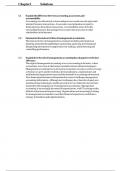Exam (elaborations)
Solutions Manual for Accounting For Managers Interpreting Accounting Information for Decision Making 4th Edition By Paul M. Collier
Solutions Manual for Accounting For Managers Interpreting Accounting Information for Decision Making 4th Edition By Paul M. Collier
[Show more]




